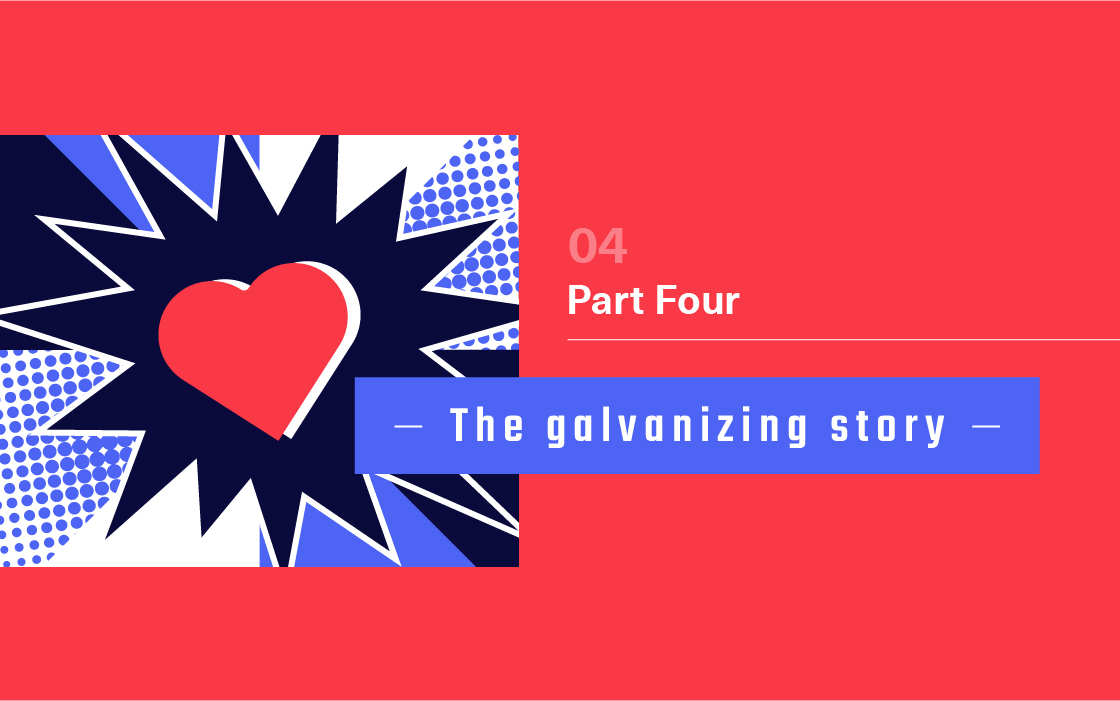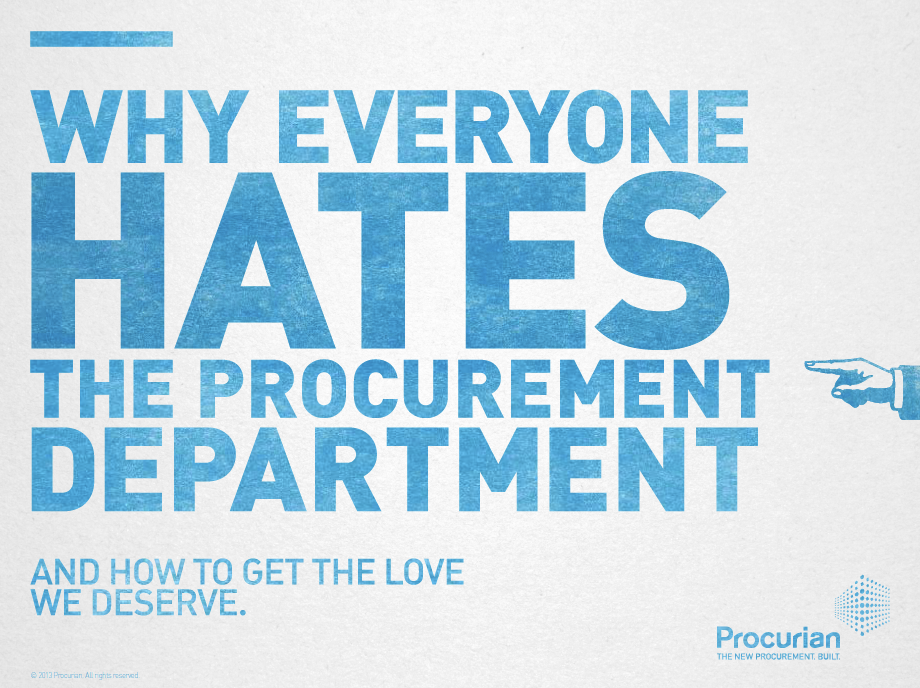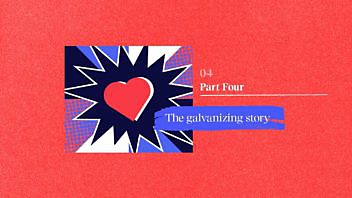The first three posts in the Galvanizing Story series were about the need for a galvanizing story and the five components that make them work (the change in the world, the new potential, the obstacle, the breakthrough and the pay-off).

But underneath the five components is something that resonates on a deeper level: the emotional core of your story and your brand.
If the galvanizing story speaks to your prospects’ heads, the emotional core speaks to their hearts.
And if you get this part right, your brand and marketing can defy the gravity that pulls most B2B marketing to the ground.
Oh, you precious little Summer Child, you.
I know, B2B is not supposed to be about (finger-quote-gesture) “feelings”. It’s supposed to be about building rational arguments that convince prospects. Like lawyers building a case.
But show me a lawyer that doesn’t recognize the importance of appealing to the jury’s heart and I’ll show you one lousy lawyer.
OJ Simpson didn’t get away with murder because the evidence of his innocence was strong (I can’t recall a weaker case); he got away with murder because the defense team made the jury really, really angry about racism in the LAPD.
All the latest work in behavioral economics—from Daniel Kahneman’s brilliant Thinking Fast and Slow to Rory Sutherland’s smart, entertaining Alchemy —prove the point over and over:
We make decisions with our hearts (or our guts) and rationalize them with our heads.
Well, if we all know that—and experience it ourselves every day—why don’t we market that way in B2B?
Consumer marketers get it. They have to get it because their products are often more or less undifferentiated things (potato chip, sneaker, perfume, watch) wrapped in a gloriously differentiated brand (Kettle!, Nike!, Chanel! Rolex!).
But in B2B, we prefer to pretend that the people we’re marketing to are rational decision-making units. Buy-bots.
They aren’t.
Find your B2B brand’s heart
If you haven’t explicitly identified the emotional core of your B2B brand, you don’t really have a B2B brand.
And if you aren’t tapping that emotional core, you’re leaving a huge amount of ‘engagement’ on the table. Which means you’re leaving money on the table.
Yes, we buy things we think will help us. But from all those options, we choose the ones we feel good about. From the companies we like.
Emotion in action
Let’s take an apparently bone-dry product category and see if we can find its heart.
Procurement software.
Surely if there’s a Dry shelf in the Boring section of the Back End library, procurement software is on it.
Surely not a feel in sight, right? On the contrary. The best procurement managers are a special kind of passionate geek: they hate waste. They loathe waste. It’s visceral.
When building a brand for procurement software, that visceral hate is a fantastic thing to tap into.
For procurement geeks, waste isn’t just an economic issue. It’s a moral issue. In a world constrained by scarcity, permitting waste isn’t just stupid, it’s wrong. And people who waste company money because they can’t be bothered to follow sensible policies must be stopped.
Tap into that feeling and procurement software isn’t just a category, it’s a holy mission.
As it happens, we once had a client in the procurement market and ended up interviewing about fifteen procurement professionals. We discovered a cool, little crystal of insight: procurement people know that nobody in their company likes them… and it feels really unfair.
Wow. Imagine if you knew that no one in your whole company really understood your job and so resented you for doing it? How would that feel?
So we hosed down the elephant in the room… and produced a piece about it:

And it performed better than any content the company had every done (and got a lot of media attention too).
Why? Because it touched on an emotional truth that nobody wanted to talk about but everybody felt.
(Procurian got bought by Accenture so if you Google the piece you won’t find it but if you email me, I’ll send it to you.) (doug@…)
Reserve some content budget for ‘heart’ content
How could your brand’s emotional heart translate into content? Well, it should infuse everything you do, in more or less subtle ways. But I really like expressing it in content whose only job is to express your emotional heart.
I want to repeat that because it’s the important bit:
Content whose only job is to express your emotional heart.
So beyond smuggling some heart into every piece of content (a very good plan), this is about creating content for this sole purpose. That kind of content will be very different from anything else you produce — and it can act like a catalyst, lighting up your whole marketing mix.
So for the procurement software company, a series of films about the tragedy of waste would be great.
It might not be about enterprise purchasing at all.
It might be about wasted food in a school cafeteria.
Or wasted water during a drought.
Or wasted energy on a warming planet.
This kind of content is an insanely hard sell for most B2B marketing teams. ‘Heart’ content fights for budget with ‘head’ content—and the head wins every time.
That’s a huge shame. Because B2B brands that do let themselves give a shit about something in public get amazing returns on that effort.
On the surface, InVision’s Design Disruptors documentary has nothing to do with InVision. Underneath, at the emotional heart level, it has everything to do with InVision.
More importantly, it has everything to do with the designers they sell to. People who believe that design is one of the greatest forces available for changing the world. (Jay Acunzo did a great podcast episode on this called “How One Brand Made A Documentary Film Feel Safer Than Another How-To Post“.)
Ask a hard-nosed Sales VP if she’d like a film like Design Disruptors for her brand and she’ll probably say, “No thanks. I’ll take the video about how our product is better than the other guy’s product.”
Well, she’s wrong.
Wrong, wrong, wrong.
The ‘soft’ piece will do SO much more for her than the so-called ‘hardworking’ one.
Because you’re not selling to buy-bots.
A commercial break (with heart)
The emotional heart and the galvanizing story
When you identify the emotional heart of your brand, your galvanizing story moves from convincing to compelling.
Let’s take the Open Market example from Post 3 in this series:
Open Market’s SMS platform turned out to really be a customer experience platform that helps companies seize the huge opportunities for “empathetic interactions”—interactions that show you understand what your customer needs right now, then delivers it, unasked.
Like when Virgin Trains sends a text to customers alerting them to the right platform for their next train before it even goes up on the big board.
Their galvanizing story is quite convincing (as I hope we showed in Post 3).
But where’s the heart?
How about here, in this sample set of beliefs:
- Empathy is the wellspring of all relationships.
- Understanding how you can help a customer starts with genuinely wanting to help.
- An empathetic act that’s unexpected is worth a hundred routine interactions.
- It is possible to deliver automated empathetic interactions if you think hard about your customer needs and design a thoughtful response to one of those needs.
I made those up, but see how exploring beliefs like this open up a whole new world of content and marketing and brand?
And how content that expresses and celebrates these beliefs and values won’t just make people think something, they’ll make them feel something?
For me, exploring the emotional heart instantly makes me want to make stuff. For the Open Market beliefs, how about:
- A film that’s simply a montage of people’s faces at the moment they receive an unexpected gift.
- A series that drills down into the dynamics of empathy. What is it? Why do humans have it? Why was it adaptive for our species? How does it affect others?
- A film about ethnography in business: how observing any target audience reveals insights and empathy opportunities.
All this… for an SMS delivery platform?
Hard-Nosed-Bastard: “Wait, you want to do a video of delighted faces instead of that handy comparison guide to global text rates?”
Smart Marketer: “No, not instead of, in addition to. It’s all about a content mix. Head and heart.”
Don’t let the haters stop you
You can’t explore the heart of your brand very far before someone sends you a link to Simon Sinek’s book or TED talk, Start With Why. (See? I just did).
His premise, crisply delivered, is that people don’t buy what you make, they buy why you make it.
The talk went huge—rightfully so—and while it inspired a lot of great work, it also led to some really bad marketing (like Kylie Jenner saving the world with a can of Pepsi).
In no time, every brand was scrambling to Find it’s Why and shove it in people’s faces.
Predictably, the backlash kicked in. The Sinek-Cynics came out of the woodwork (including our own Adam Ketterer) to bring marketers back to Earth.
But blaming Sinek’s idea for all this bad marketing is like blaming fire for burnt toast and… melted marshmallows and stuff.
The phony ‘meaning-driven’ marketing fails because it’s phony. Because the meaning was just too far divorced from the brand. The connection too tenuous.
Or because the brand doesn’t walk the talk at all. It just wants credit for having a heart that actually shriveled up years ago. (Katie Martell writes brilliantly on this, especially in her article “Pride or Pandering?”.)
Activating your brand’s emotional heart in 3 steps.
K, so here’s what I urge you to do:
Identify your brand’s emotional heart.
What does success feel like for your prospects? What does failure feel like? What fears does your offer trigger? Where’s the visceral urge behind all this?
Track down the beliefs and values it implies.
Why did the founders start the company in the first place? What does your company believe that few others believe (or act on)? What values drive what you do? What’s your ‘why’ and how does it make you feel?
Celebrate those beliefs and values in public, tapping into those emotions.
Produce content that has only one job — don’t just smuggle into that ebook. Unfurl it in full, for its own sake.
You can do this.
I babble on about a lot of marketing topics. This one is maybe the most important.
I really believe that most B2B marketers are ignoring the single most powerful tactic available to them.
And that if we do find ways to tap into the emotional heart of our brands, our markets will open up for us. And that it can multiply the impact of all the marketing we do and all the content we produce.
A strong, clear Galvanizing Story with a compelling, true heart?
Unstoppable.
—
Other posts in the Galvanizing Story series
Part 1: An introduction to the galvanizing story

Enjoyed this article?
Take part in the discussion








Comments
There are no comments yet for this post. Why not be the first?